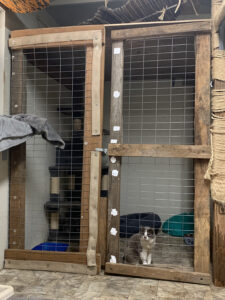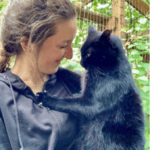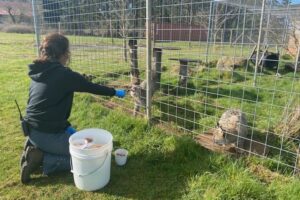A Day in the Life of a Keeper
Part 2: The Afternoon Routine
In this week’s Keeper Journal, we’re going to pick up right where we left off following the completion of all our morning responsibilities and take a look at the wide variety of tasks on our afternoon to-do list.
It can pretty much be assumed that every afternoon involves cleaning of some kind. With over 80 animals on the property, there’s always something in need of cleaning. We might be scheduled one day to clean Alpha, home to the lions and tigers because Calvin and Hobbes’s pool is starting to look a little murky. Or, we might need to plan on detailing Bravo, housing our sweet cougar Noni, because the blackberry bushes are wreaking havoc on all the other trees and shrubs.
So we gather up our supplies, making sure we’ve got enough straw to refresh den boxes, extra batteries for the weed whackers, and something fun and tasty for enrichment, and head out, rain, snow, or shine.
Even though regular cleaning is definitely part of the routine, it isn’t as boring or tiresome as it might sound. We get to experience the cats and their unique personalities, watch them engage with their enrichment, and, since the cleaning schedule changes so frequently, it’s not very often that you find yourself cleaning the same enclosures week after week – because just as we have to keep things new and exciting for the cats, we’ve got to change things up for us keepers as well!
Once we’ve completed the day’s big clean, we usually find ourselves with a little bit of leftover time for projects. These projects might include anything from landscape maintenance to crafting new structures to enhance the lives of cats.
One of our most recent projects included designing, building, and installing lockout crates on every enclosure. These lockout crates help streamline feeding, helping us make sure everyone gets their proper amount of food and meds, as well as minimize potential scuffles between roommates. After all, no one likes it when someone takes your chicken heart.
 Another project we completed, and which we’re all rather proud of, included building a quarantine crate in our domestic cat house. This crate, which is large enough to fit all five of us keepers inside, was crafted from wood and wire to create a small little “room,” so to speak, in which we can house new cats or recovering cats, or anyone who just needs some extra care and attention. Without causing them undue stress by moving them elsewhere, this large crate allows us to keep a kitty in an area familiar to them, while still making sure they get the right amount of food, TLC, and medical care necessary.
Another project we completed, and which we’re all rather proud of, included building a quarantine crate in our domestic cat house. This crate, which is large enough to fit all five of us keepers inside, was crafted from wood and wire to create a small little “room,” so to speak, in which we can house new cats or recovering cats, or anyone who just needs some extra care and attention. Without causing them undue stress by moving them elsewhere, this large crate allows us to keep a kitty in an area familiar to them, while still making sure they get the right amount of food, TLC, and medical care necessary.
Mabel, who recently underwent surgery to remove the cancerous cells from her nose, was the first to test out this keeper-made quarantine crate, and we’re pretty confident that so far, her reviews have come back positive.
Once we get our projects wrapped up, usually around 4 p.m. each day, we begin closing procedures, locking up all perimeters, checking livestock water levels, making sure meat is ready for the next day, charging the golf carts, and marking down any end-of-the-day notes. Of course, while this is all routine and what a daily afternoon schedule usually looks like, it can be upset and changed around in the blink of an eye, depending on which cat needs what when – after all, they run this place. We just work here.





